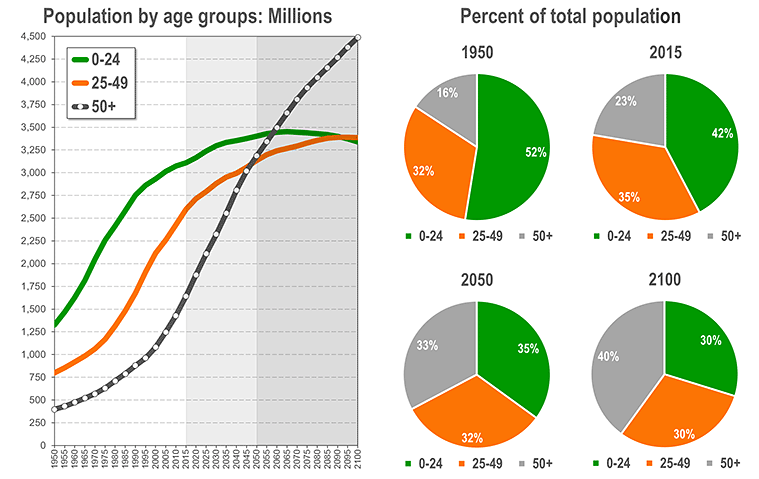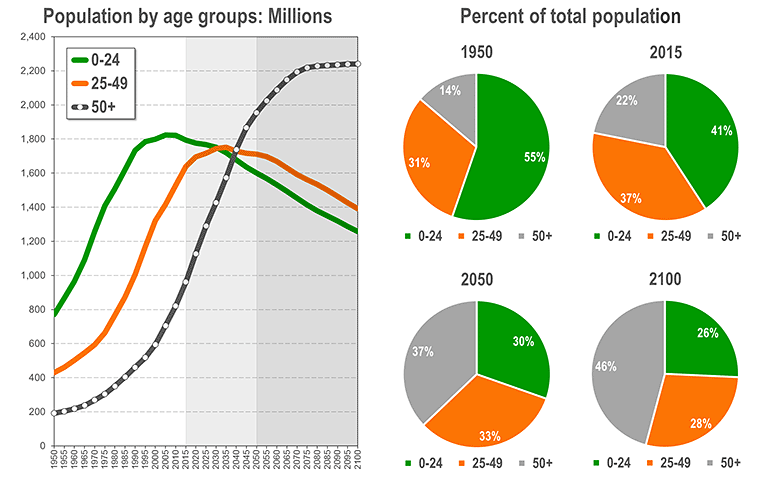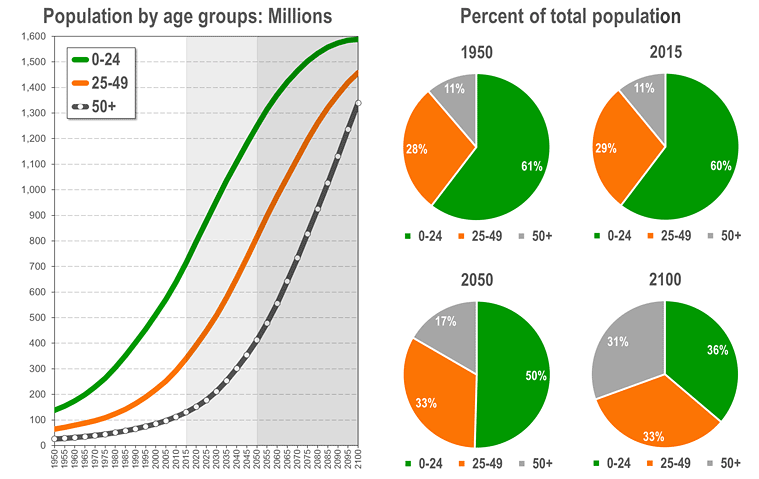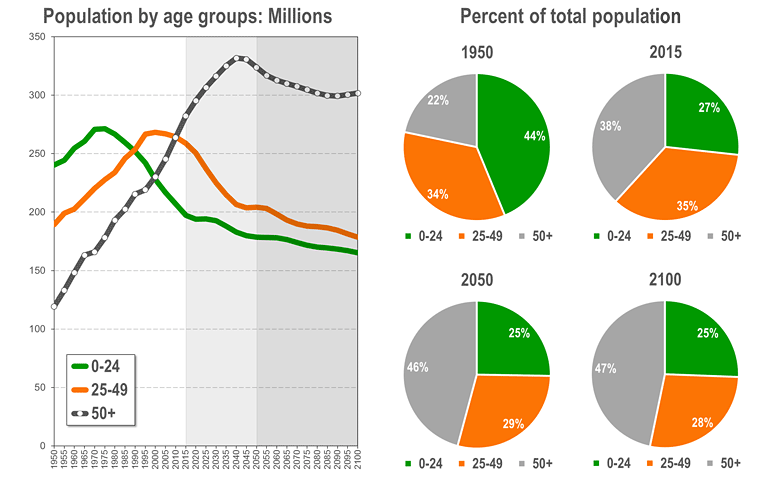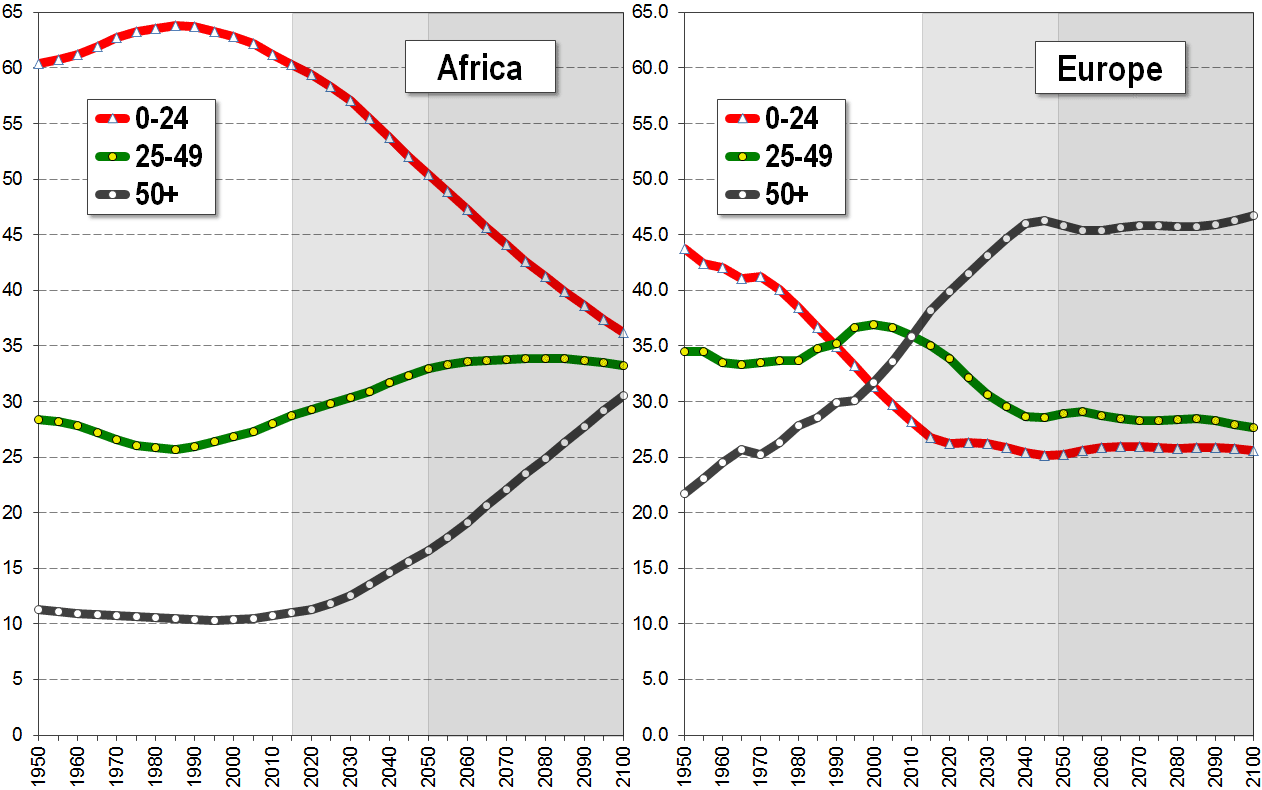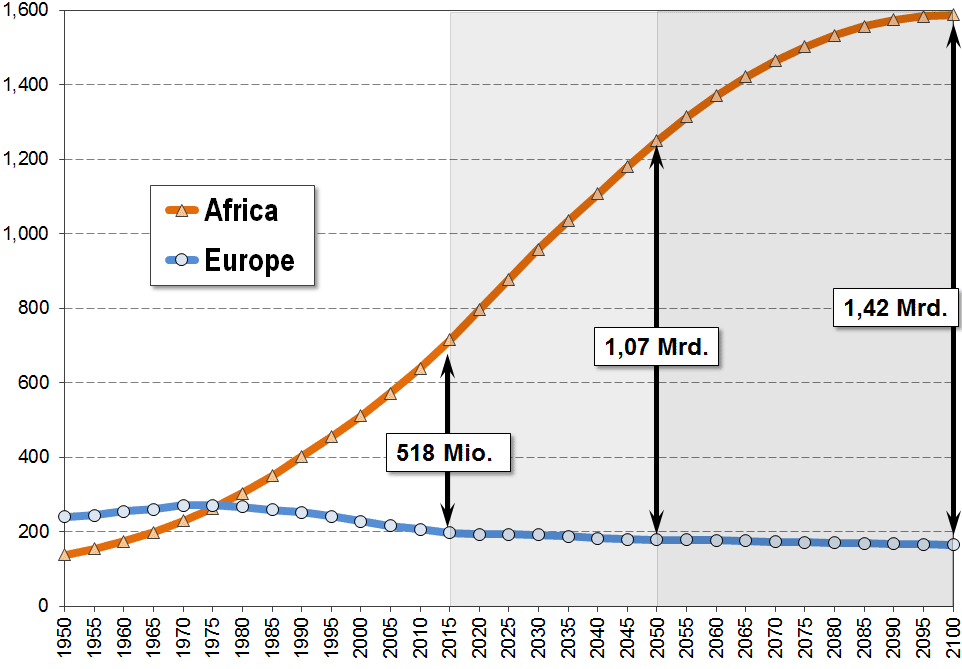
By contrast, the number of children and young adults, which has increased from around 1.3 billion in 1950 to 3.1 billion today, will "only" increase to 3.4 billion over the next 35 years, and may decline to 3.3 billion by the end of the century. While in 1950, more than half of the world's population were children and young adults (52%) their share may decline to 30% by 2100.
Worldwide, the percentage of people in main working age between 25 and 49 years may remain almost constant between 30 and 35 percent over the 150 year period between 1950 and 2100.
Lee, R. D. (1994a). The formal demography of population ageing, transfers, and the economic life cycle. In: Demography of Ageing, L.G. Martin and S.H. Preston, eds.. Washington, D.C.: National Academy Press, pp. 8-49.
Lee, R. D. (1994b). Population, age structure, intergenerational transfers, and wealth: a new approach, with applications to the United States. In The Family and Intergenerational Relations, Journal of Human Resources, P. Gertler, ed., pp. 1027-1063.
Mason, Andrew (2001). Population and Economic Growth in East Asia. Population Change and Economic Development in East Asia: Challenges Met, Opportunities Seized. A. Mason. Stanford, Stanford University Press: 1-30.
Mason, Andrew, Thomas Merrick, and R. Paul Shaw, eds. (1999). Population Economics, Demographic Transition, and Development: Research and Policy Implications, WBI Working Papers (Washington, DC: World Bank Institute).
Today, only 41% of Asia's population are children and young adults age 0-24 years; and over the next 35 years their share of the population will decline to only 30%. By the end of the 21st century, Asia's population will have only 26% of children and young adults.
By contrast, the number of older people age 50 and above has increased from around 192 million in 1950 to 961 million today. Over the next 35 years the number of older people will more than double to almost 2 billion in 2050. By the end of the century Asia will have more than 2.2 billion people aged 50 years and above - roughly a billion more than the number of children and young adults under the age of 25. At that time 46% of Asia's population may be people aged 50 and above - up from 14% in 1950.
The population in peak working age from 25 to 49 has increased in Asia from some 431 million in 1950 to more than 1.6 billion today - their population share has also grown from 31% to 37%. However, this will change dramatically over the next few decades. By 2050, Asia's peak working age population will be just 1.7 billion - and will begin to decline. By the end of the 21st century Asia my have just 1.4 billion people in peak working age of 25-49 years - roughly 28% percent of the population.
Mason, Andrew / Lee, Sang Hyop (2011): Population Aging and Economic Progress in Asia: A Bumpy Road Ahead? Honolulu, Hawaii. Analyses from the East-West-Center, No. 99
And the numbers will further increase: Within only 35 years, Africa will have almost 1.3 billion children and young adults under the age of 25. However, over the same time, their share of the total population will decline to only 50%.
By the end of the 21st century, Africa could have almost 1.6 billion children and young adults under the age of 25 - a mind-boggling number compared to any other region of the world. Yet, due to Africa's enormous population growth, they will "only" make up 36% of the population in 2100.
But children and young people are by no means the only age group in Africa that will experience enormous growth: The number of people age 50 and above has already increased from a mere 26 million in 1950 to 130 million today. Over the next 35 years their number will "explode" to 412 million; and by the end of the 21st century, Africa may be home to more than 1.3 billion people age 50 and above.
Thus, the number of older people age 50 and above in Africa may be 52 times larger by the end of the 21st century than during the middle of the 20th century. Their share of the population may have almost tripled from 11% to 31%.
This seismic shift in Africa's age structure is a consequence of the continent's delayed fertility decline. Very high fertility rates, despite relatively low infant and child mortality, has already resulted in an enormous number of children and young adults under the age of 25 in many African countries (particularly in Western and Eastern Africa).
It is high time, that African leaders are called to account by their own people - and if necessary - by the world community to truly develop their nations. Billions of young people in Africa need food, education, health care, housing, infrastructure and, above all, jobs. Current economic growth is entirely insufficient if up to 50% of young people in African cities are without work. Africa urgently needs economic and political reforms, similar to those that have lifted hundreds of millions of people out of poverty in China and other parts of Asia. Without such development, Africa's young people will be a "lost generation without future".
Even more significant is the decline in the number of children and young adults aged 0 to 24 in Europe: Their number has already declined from 240 million in 1950 to 197 million today. Over the next 35 years their number will further shrink by 18 million to 179 million in 2050; and by the end of the 21st century Europe may have just 165 million children and young adults. Their share of the population may decline from 44% in 1950 to 25% in 2050 and 2100.
However, the most dramatic change in Europe's age structure is the increase in the number of older people age 50 and above. In 1950, only 22% of the European population was in this age group; today they already make up 38% of the population; and within only 35 years the percentage of older people age 50 and above will increase to 46% of the population. For the rest of the 21st century, almost half of the European population (46%-47%) will be age 50 or above.
The absolute number of people age 50 and above has already increased from 119 million in 1950 to 282 million and will peak around 2040 with 332 million. Then it will slowly decline to 302 million in 2100.
Many demographers have warned policy makers for several decades that the continent's extremely low sub-replacement fertility rates are entirely unsustainable and would lead to extreme population aging and decline. But ignorance and ideological blindness has won the political debates and only few European nations (such as France and Sweden) have implemented effective population and social policies to increase fertility.
The same people (particularly in German speaking countries), who have argued against effective measures that could have increased fertility, are now welcoming mass-immigration from outside of Europe to compensate looming population aging and decline. Rather than facilitating and promoting larger families within Europe, these politicians now favor multi-cultural, multi-ethnic and multi-racial societies based on large-scale immigration from outside Europe - particularly from Africa and Western Asia. This will lead to a demographic and social diversity explosion in Europe - making Europe more similar to the United States of America (Frey, 2014).
Unfortunately, the demographic, social, racial, economic, political, geo-strategic and security implications of such large-scale immigration are hardly ever discussed. It is therefore quite likely that many European countries will be facing decades of demographically-induced challenges and risk - either from their still extremely low fertility causing population aging, or from unmanageable high levels of immigration causing social and economic conflicts.
Kassam, Ashifa and Rosie Scammell, Kate Connolly, Richard Orange, Kim Willsher, Rebecca Ratcliffe. 2015. Europe needs many more babies to avert a population disaster. Across Europe birth rates are tumbling. The net effect is a ‘perfect demographic storm’ that will imperil economic growth across the continent. The Guardian, 23 August
Lee, R. D. 1994. The formal demography of population ageing, transfers, and the economic life cycle. In: Demography of Ageing, L.G. Martin and S.H. Preston, eds.. Washington, D.C.: National Academy Press, pp. 8-49.
Margolis, Rachel / Myrskylä, Mikko. 2015. Parental Well-being Surrounding First Birth as a Determinant of Further Parity Progression. In: Demography, Vol. 52, Issue 4, pp 1147-1166
Mason, Andrew, Thomas Merrick, and R. Paul Shaw, eds. 1999. Population Economics, Demographic Transition, and Development: Research and Policy Implications, WBI Working Papers (Washington, DC: World Bank Institute).
Population aged 0-24, 25-49, 50+ (percent)
It may be surprising, but the difference between Africa and Europe in the percentages of main working age population (between 25 and 49 years of age) is not not huge: 29% of Africa's population and 35% of Europe's population is in the age group between 25 and 49 years.
However, there is a much higher proportion of people age 50 and higher in Europe than in Africa: 38% in Europe versus 11% in Africa.
Population aged 0-24 (millions)
For comparison: Europe has just 197 million children and young adults aged 0 to 24 years - less than in the early 1950s, when Europe had 240 million people under age 25.
As a consequence of todays young population and the still relatively high fertility, Africa will see an explosion in the number of children and young people over the next few decades: By 2050, Africa will have around 1.25 billion children and young adults under age 25; and by the end of the century Africa will most likely have almost 1.6 billion children and young adults aged 0 to 24 years.
Today (2015), the number of children and young adults is about 518 Million higher in Africa than in Euroe; by 2050, Africa will have roughly one billion more children and young adults than Europe; and by the end of the century it is likely that Africa will have 1.4 billion more children and young adults than Europe. All this assumes that fertility will decline significantly in Africa - otherwise, the numbers would be even higher.>
Sippel, Lilli / Kiziak, Tanja / Woellert, Franziska / Klingholz, Reiner(2011) Africa’s Demographic Challenges. How a young population can make development possible. Berlin Institute for Population and Development in Cooperation with DSW.
